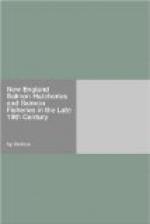The water supply is derived from Craig Brook and from three large and several lesser springs. The source of the brook is Craig Pond, which affords a constant supply of exceedingly transparent water, warm in summer and cold in winter, moderated, however; in both extremes by the water from the springs, which mingles with the brook in its lower course, forming about a third of its volume. It is this mixed water which is mainly used in the rearing of fish. Its temperature ranges from 34° F. [1.1° C.] to 70°F. [21.1°C.]. The lowest monthly mean in 1893 was 35.8° F. [2.1° C.] in February. The highest was 64.6°F. [18.1°C.] in August. The total volume is variable, ranging from 875 to 3,000 gallons and averaging about 1,200 gallons per minute.
The difference of level between the source and mouth of the brook is about 190 feet. The sharpest descent is just above the hatchery and rearing troughs, which therefore receive well-aerated water. The conformation of the ground offers good facilities for the distribution and utilization of the water.
The leading motive in the foundation of this station was the desire to apply to the Atlantic salmon the system of rearing fish to the age of at least several months before liberating them. This motive has determined not only the principal subjects of the work, but also to a considerable extent the fixtures and methods. The scheme of work was determined in outline several years before the acquisition of full title to the premises, and, circumstances rendering it desirable to enter at once on its development, it became necessary to have recourse to movable apparatus, pending authority for permanent improvements.
Hence the erection of a series of small troughs in the open air, which gave such excellent satisfaction that enlargement took the same direction; and it has thus come about that the rearing operations of the station down to the present time have been almost exclusively conducted in open-air troughs. A series of ponds has been constructed, but with the exception of a few small ones none of them have been as yet brought into use.
The troughs are for the most part such as are used in the hatchery for the maturing of spawn, and their form and size have been adapted to the hatching apparatus which has been in use at the Maine station for many years. The eggs are developed on wire-cloth trays measuring 12 and one half inches in width and length, and the troughs are therefore 12 and three quarter inches wide. Their depth is 9 inches and their length is 10 feet 6 inches. Such short troughs were adopted for two reasons:




